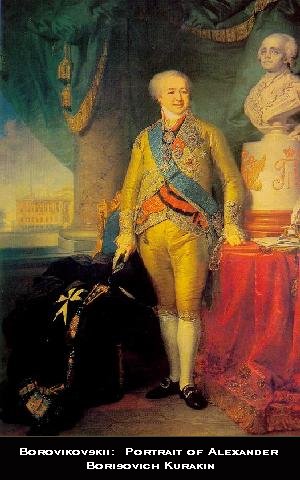

Borovikovskii was born in a noble family in Mirgorod, in 1757. Despite his talent for drawing, he joined the army and dedicated himself to art only after his retirement. He divided his time between painting icons and portraits. The artist owes the change of his fate to Catherine II. During one of her trips to the south of Russia, the Empress stopped at Kremenchug and commissioned from Borovikovskii two allegorical canvasses of herself. She was so impressed with the results that she invited the artist to St. Petersburg. In the capital, Borovikovskii met Dmitrii Levitskii and became his student. The artist became so popular that he had great difficulties with fulfilling all of his commissions. Moreover, the fame of the secular world seemed to contradict his deeply religious beliefs. He always considered religious painting his main goal in life and his activities as divine predestination. At the end of his life, his dreams came true: he devoted himself almost exclusively to religious art and even considered becoming a monk. He died in 1825, but his artistic legacy was preserved and developed by one of his most talented students, Aleksei Venetsianov. Borovikovskii is one of the most charming, even enchanting Russian painters of the 18th century. His exquisite taste can be seen in his harmonious combination of olive, lilac, and pearly silver tones with stronger primary colors. But the harmony of colors is not the goal in itself -- it leads to the world of peace, tranquility, and "sweet dreams." Through his art Borovikovskii shows his belief in the possibility of harmonious coexistence of man and nature. The women in the artist's canvasses are immersed in poetic, dreamy atmosphere. The trees in the background replicate with their branches and leaves the outlines of the figures. The details do not obscure the spirituality of the portrayed women; their inner worlds, their "eternal feminine" manifests itself in the sparks of their eyes, in their hand gestures, in their lips, in their hair, even in their clothing.
The Portrait of Anna Ivanovna Bezborodko with Her Daughters Liubov' and Cleopatra (1803) demonstrates how Borovikovskii embodies in his art such sentimentalist ideas as friendship and familial devotion, the tender unity of hearts and nobility of pure feelings. The decorative background with a landscape -- an attribute of nature, the true sphere of existence -- completes the idyllic picture of family happiness. The dignity of human relationships and the sensitivity of the human soul are reflected in the refined beauty of the portrait's form. All the elements of the painting -- from the graceful gestures of the mother and her children, through the masterfully rendered details, to the virtuosity of the drawing and the perfect technique of applying paint without leaving visible brush strokes on the canvas-- turn the work into a precious object. An interesting contrast to Borovikovskii's female portraits can be seen in the Portrait of Aleksandr Borisovich Kurakin (1801-2). The painting continues or perhaps brings to its conclusion the development of the ceremonial portrait of the eighteenth century. Following the existing tradition, Borovikovskii shows the vice-chancellor at the court of Paul I standing, in formal clothes, on the background of a column and a heavy
drapery. Numerous details emphasize the closeness between the prince and the Emperor; the most important of those is the cross of the Order of the Knights of Malta (the Emperor was its founder and Grand Master), which appears four times on the Prince's tailcoat and once on the black velvet cape. To leave no doubt about Kurakin's devotion, Borovikovskii places him next to a statue of Paul, decorated with a gold double-headed eagle and the Emperor's insignia. The artist's painterly technique can be seen as an artistic metaphor for Kurakin's nickname, "The Diamond Prince." The painting looks like an expensive jewel -- this effect is achieved through Borovikovskii's amazing ability to show minute details (the lace cuffs, the diamond-studded medals, the curtain tassels) and to contrast the textures of various materials, from the soft black velvet to the crisp brocade and the solid marble and plaster. The brightness of
the colors also contributes to the jewel-like radiance of the painting. [A.B.] [Sources: Klimov, Zotov, Fateev, Barlamova].

